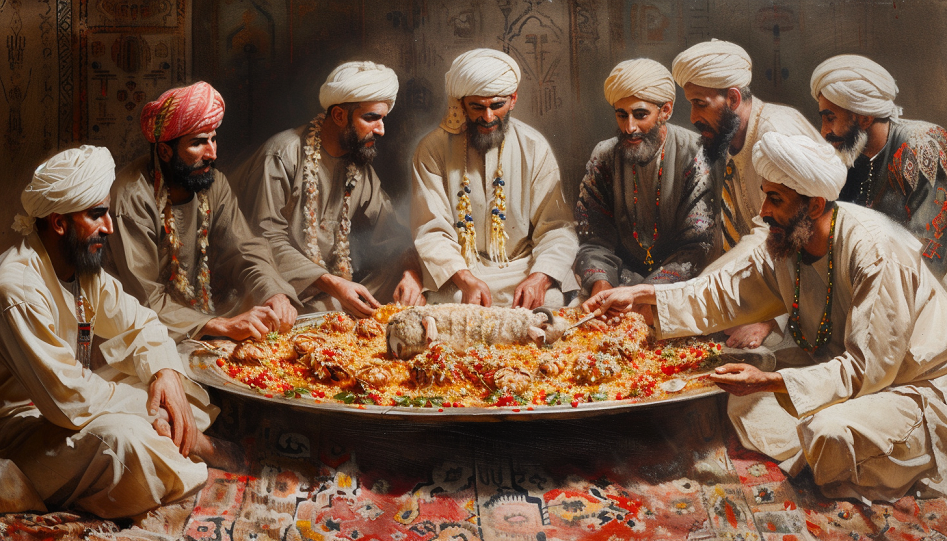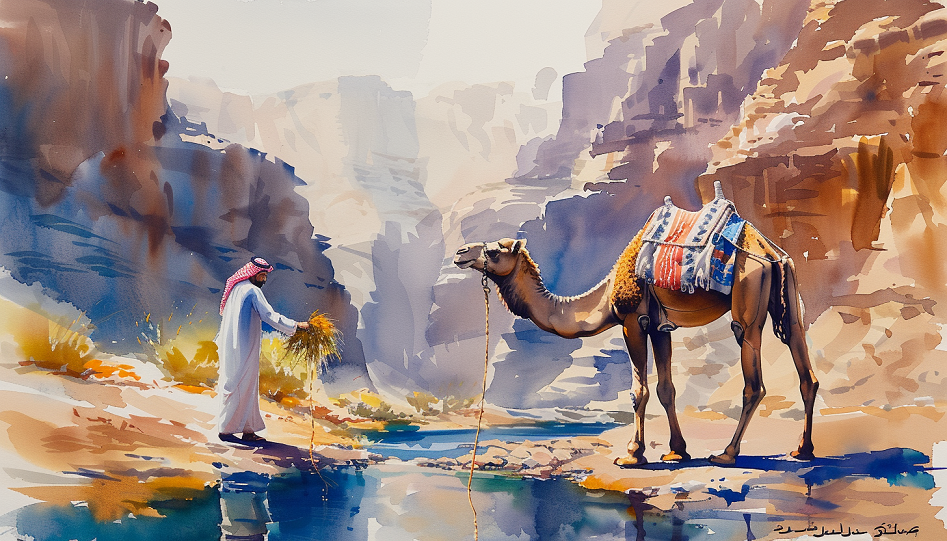In the early 20th century, Harry St. John Philby, an explorer and writer, embarked on a journey into the heart of Saudi Arabia, an expedition that would later be meticulously documented in his book “Heart OF Arabia”. This essay delves into Philby’s fascinating observations and experiences in Al Hasa, an oasis of cultural richness and geographical marvel situated on the eastern coast of KSA. Through Philby’s eyes, we explore the contrasting landscapes of Saudi Arabia, from its vast deserts to the verdant oasis, and encounter the people, customs, and daily life that define this unique region. Key locations such as Jisha and the palm-belt of Al Hasa, along with notable figures like Amir Ahmad ibn Sail, serve as focal points in our exploration. Philby’s narrative offers a window into the Arabian way of life, providing insights into the social fabric, economic dynamics, and the deep-rooted traditions of its inhabitants.
- Al Hasa’s agricultural richness and irrigation systems are central to the region’s survival and prosperity.
- Market dynamics in villages like Jafar and Jisha highlight a vibrant local economy driven by agricultural produce.
- The architectural and social fabric of Al Hasa is shaped by its environmental conditions and available materials.
- Philby’s journey offers invaluable insights into the cultural and historical landscape of early 20th-century Saudi Arabia.
Arrival at Al Hasa
Philby’s journey into Al Hasa begins with a moment of reverence and awe as he and his fellow travelers crest the final rise and behold the oasis for the first time. This moment is encapsulated in the collective exclamation, “La ilaha illa ‘llah! La ilaha illa ‘llah!” (There is no God but God) – a testament to the overwhelming joy of reaching one’s destination and the contrast between the harsh desert and the sudden emergence of life in the oasis. Philby describes this transition with a sense of wonder, noting the “sordid setting of boundless desert” that gives way to the oasis, a testament to the divine creativity and the stark contrasts that define the Arabian landscape.
The oasis of Al Hasa, with its “ascending smoke of its scattered hamlets,” signals the presence of human life and civilization amidst the desolation, urging the travelers to hasten their steps to reach shelter before nightfall. Despite the apparent proximity, the journey to the edge of the palm-belt proves to be arduous, taking the weary caravan an additional hour to traverse the three miles of intervening plain. Their arrival at dusk, between the village of Jisha and the welcoming shade of the palms, marks the end of their day’s journey and the beginning of their immersion into the life and customs of Al Hasa.
Philby’s initial impression of Al Hasa is one of stark contrasts and divine artistry, a theme that resonates throughout his account. The oasis, with its life-sustaining water and greenery, stands as a beacon of survival and community in the vast emptiness of the desert. This juxtaposition not only highlights the physical challenges of the Arabian landscape but also underscores the resilience and adaptability of its people.
Hospitality and Trade in Hasa
Upon their arrival, the weary travellers are greeted not just by the physical beauty of Al Hasa but also by the warmth and hospitality of its inhabitants. Philby and his companions quickly become participants in the local economy, engaging in trade with the villagers who approach them with goods for sale. This exchange of “lucerne for the camels, dates for the men” is a simple yet profound interaction, highlighting the mutual dependence and respect between the travellers and the local community.
The group’s wanderings in the date groves further immerse them in the agricultural wealth of the oasis. Philby is taken by the “pleasant babbling streams” and the lush fields of lucerne, corn, and the variety of fruit trees that thrive in this fertile land. This idyllic setting provides a stark contrast to the arduous journey through the desert, offering a moment of respite and appreciation for the oasis’s natural abundance.
Meeting with Amir Ahmad ibn Sail
The hospitality extends beyond simple trade as Philby and his companions are invited by the Amir of Jisha, Ahmad ibn Sail, to partake in coffee and discussions. Despite the Amir’s afflictions, particularly his eyesight, his engagement in the pilgrimage to Mecca and his governance of Jisha in his absence is a testament to his commitment and resilience. This meeting, set in the “narrow parlour of the Amir’s residence,” becomes a cultural exchange, with conversations touching upon the wider world beyond the oasis.
Philby’s interaction with the Amir and the villagers of Jisha illustrates the depth of Arabian hospitality, where even weary strangers are welcomed and engaged in meaningful dialogue. The mention of the Amir’s pilgrimage to Mecca also underscores the spiritual dimension of life in Al Hasa, reflecting the deep religious faith that guides the community’s daily activities and interactions.

Cultural Observations
During his stay, Philby becomes a keen observer of Arabian hospitality, particularly the traditions surrounding the serving of tea and coffee. These moments of shared beverages become more than just a respite; they are a ritual that fosters community and connection. The preparation and serving of coffee, a cultural hallmark of the region, is noted by Philby with an appreciation for the intricate customs that accompany this simple act of hospitality.
“The preparation of incense; a censer of coarse Ithil-wood, roughly ornamented with strips of tin, was produced from the cupboard by the hearth,” Philby notes, capturing the ceremonial aspect of Arabian hospitality that extends beyond mere food and drink, encompassing an entire ethos of welcome and respect.
Communal Meals
The culmination of the day’s experiences in Jisha is marked by a communal feast, a vivid illustration of the social bonds and cultural practices that underpin Arabian society. The preparation of the meal itself, with a “large tray… borrowed for the occasion from the village,” upon which the limbs of the sheep are piled high atop a mound of steaming rice, signifies not only the generosity of the hosts but also the communal nature of eating in Arabian culture. Philby captures the essence of this moment with the collective utterance of gratitude, “Lillahi al Hamd wa ‘Ishukr, bismillahi ‘lrahmani ‘lrahim,” (To God belongs praise and thanks, in the name of God) before the meal commences, highlighting the deep intertwining of faith and daily life.
This scene, illuminated by the “garish light of the camp-fire,” becomes a tableau of shared humanity, with Philby noting the contrast between his cautious approach to the hot food and the eager participation of his companions. The act of sharing a meal, beyond its physical sustenance, serves as a profound communal ritual, reinforcing social ties and communal identity. Philby’s observation of the etiquette involved—where each person begins with a handful of rice before delving into the meal—underscores the cultural norms that guide even the most basic of human activities.
Architectural and Social Insights
Beyond the feast, Philby’s account provides insights into the architectural and social fabric of Jisha. The descriptions of the limestone houses, “rough-hewn and roughly mortared,” offer a glimpse into the practical and aesthetic considerations of local architecture, shaped by the available materials and environmental conditions. The weekly market, serving as a hub for the exchange of garden produce, further illuminates the economic and social rhythms of village life, showcasing the importance of agriculture and trade in sustaining the community.
Philby’s reflections on the market activities and the architecture of Jisha paint a picture of a society that, while rooted in tradition, is adept at navigating the challenges of its environment. The communal meal and the insights into Jisha’s social and economic structures reveal a community where hospitality, faith, and a deep connection to the land are central to its identity.
“In the name of God the merciful, the compassionate,” echoes through Philby’s narrative, not just as a prelude to the communal meal but as a mantra that encapsulates the ethos of Arabian culture. This phrase, emblematic of the intertwining of faith and daily life, serves as a guiding principle for the community’s approach to hospitality, architecture, and social organization.
Journey Through the Heart of Al Hasa
Philby’s exploration continues as he ventures further into the heart of Al Hasa, traversing the lush palm-belt that defines this fertile oasis. This segment of his journey offers a deeper understanding of the agricultural practices and the natural beauty that sustains the communities within the oasis.
Agricultural Richness
The narrative vividly describes the passage through the palm-belt, with its “rough bridges of palm-logs” and “culverts of solid cement,” which facilitate the journey amidst a network of “murmuring streams.” This intricate irrigation system, essential for the cultivation of the land, showcases the ingenuity and resourcefulness of the local inhabitants in harnessing the natural resources of the oasis. The presence of lucerne, young corn, and strips of rice amidst the “stately rows of palm-stems” underlines the agricultural diversity that characterizes Al Hasa.
Philby’s admiration for the “grateful shade” provided by the palms and the “profusion of fruit-trees, weeds, and vegetables” beneath them reflects the symbiotic relationship between the people of Al Hasa and their environment. This agricultural bounty, nurtured by the oasis, forms the backbone of the local economy and the diet of its inhabitants, illustrating the oasis’s role as a life-sustaining haven in the desert.

Market Dynamics in Jafar
The exploration leads Philby to the village of Jafar, where the vibrant market scene captures the economic and social vitality of the oasis. The “numerous booths of matting, erected after the Hasa fashion on market-days,” become a focal point for trade and interaction, drawing people from surrounding villages. The array of goods on offer, from “dates of good quality” to “palm-fronds, palm-fibre,” and more, reflects the rich agricultural output of the region and the entrepreneurial spirit of its people.
The bustling market of Jafar, with its “gay and merry crowd,” buying and selling, offers a snapshot of the economic interdependencies that bind the communities of Al Hasa. Philby’s observations on the movement of goods and people between Jafar and Jisha on market days underline the interconnectedness of the oasis’s villages, both economically and socially.
Through this journey, Philby not only charts the physical landscape of Al Hasa but also maps the intricate web of agricultural, economic, and social practices that sustain life in this verdant oasis. His narrative, rich with detail and appreciation for the land and its people, paints a vivid picture of an oasis in harmony with its environment, where the cycles of nature and human activity are closely intertwined.
“Through these groves flows the main stream of Barabar,” Philby remarks, encapsulating the essence of Al Hasa’s agricultural heartland. This observation not only highlights the importance of water management in the oasis but also serves as a metaphor for the flow of life and commerce that sustains the community.
Detailed Observations of Villages and Agriculture
As Harry St. John Philby delves deeper into the fabric of Al Hasa, his account becomes a meticulous study of the oasis’s various villages and their agricultural practices. This detailed exploration sheds light on the diversity within the oasis and the sophisticated agricultural techniques that have allowed these communities to thrive in such a challenging environment.
Villages Among the Groves
Philby’s journey introduces us to several villages nestled within the palm groves of Al Hasa, each with its own character and population. He notes the distinctiveness of villages such as Subat, with about 400 inhabitants, and Al Markaz, often referred to as Markaz al Qara due to its proximity to the Qara hill, housing around a thousand residents. These villages, though smaller in scale compared to Jisha, play a crucial role in the agricultural ecosystem of the oasis. Philby’s failure to record the names of all the villages he encounters suggests the vastness of Al Hasa and the numerous communities that contribute to its vibrancy.
Gardens and Irrigation
The heart of Al Hasa’s agricultural success lies in its magnificent gardens and the intricate irrigation system that feeds them. Philby marvels at the well-kept groves, where the “orange and lemon trees of sombrest green” stand in “regular rows amid the colonnades of great palm-stems.” He specifically mentions Mardhiyya, a garden once owned by the Ottoman Sultan, and Abu Laila, a garden named after a romance that speaks to the personal histories intertwined with the land. These gardens, alongside the main irrigation streams of Barabar, Sulaisil, and Wajjaj, are central to the oasis’s ability to sustain such a rich variety of crops.
Philby’s narrative captures the essence of Al Hasa’s agricultural practices, highlighting not only the physical layout and technical aspects of irrigation but also the cultural and historical significance of the land. The gardens and fields of Al Hasa are more than just sources of sustenance; they are repositories of stories, traditions, and a testament to the ingenuity of the people who have cultivated this land for generations.
“Once crown-property of the Ottoman Sultan and now registered as Bait al Mal,” Philby notes about Mardhiyya, encapsulating the historical shifts in ownership and the layers of history that permeate the landscape of Al Hasa. This observation reflects the deep connection between the land and its people, where every garden, stream, and palm tree is imbued with the legacy of those who have tended them.
Insights into Local Economy and Social Structure
Philby’s journey through Al Hasa not only unveils the physical and agricultural landscapes of the region but also provides valuable insights into the local economy and social structure. His observations reveal a society deeply connected to its environment, with social practices and economic activities that have evolved to meet the challenges of life in an oasis.
The market dynamics in villages like Jafar and Jisha highlight a vibrant local economy where agricultural produce plays a central role. The variety of goods traded, from high-quality dates to essential agricultural by-products like palm-fronds and palm-fibre, demonstrates the self-sufficiency of the oasis communities. Philby’s account of these market days, bustling with activity and commerce, paints a picture of a society where every individual, regardless of their role, contributes to the collective prosperity of the community.
This intricate web of economic interactions is underpinned by a social structure that values community, hospitality, and mutual support. The communal meals, the shared rituals of tea and coffee, and the exchanges at the market all serve to reinforce social bonds and a sense of belonging among the inhabitants of Al Hasa. These practices are not mere traditions; they are the foundation upon which the society of the oasis is built, ensuring resilience in the face of environmental challenges and fostering a deep connection between the people and their land.
Philby’s exploration of Al Hasa thus reveals a community where economic activities are closely tied to social practices, and where the challenges of the natural environment have been met with ingenuity and cooperation. The oasis is not just a geographical location but a complex ecosystem of human and natural elements, where the rhythms of daily life are synchronized with the cycles of agriculture and the seasons.
“Where each man is a husbandman of his own or others’ groves or fields,” Philby reflects, encapsulating the essence of the oasis’s economy and social structure. This observation underscores the collective effort required to cultivate the oasis and the shared responsibility for its success. In Al Hasa, the land and its people are inextricably linked, with each contributing to the well-being and prosperity of the other.
Conclusion
Through the eyes of Harry St. John Philby, the journey into Al Hasa unfolds as a rich tapestry of geographical wonders, agricultural mastery, and deeply rooted cultural practices. Philby’s narrative, derived from his book “Heart Of Arabia,” offers an intimate glimpse into the heart of Saudi Arabia during the early 20th century, revealing the resilience, ingenuity, and hospitality of its people.
FAQ Based on the Essay
Q: What is the significance of Al Hasa in Philby’s journey?
A: Al Hasa represents a focal point of agricultural prosperity, cultural richness, and community spirit in the Arabian landscape.
Q: How do the people of Al Hasa manage their agricultural practices?
A: They utilize sophisticated irrigation systems and traditional knowledge to cultivate the oasis.
Q: What role do social customs play in Al Hasa’s community?
A: Social customs foster a strong sense of community and cohesion, emphasizing hospitality and mutual support.
Q: What drives the local economy in Al Hasa’s villages?
A: The economy is largely driven by agricultural produce, with vibrant markets serving as hubs of trade and interaction.
Q: How did Philby describe the architecture of Al Hasa?
A: He noted buildings made from limestone, adapted to the environmental conditions and resources of the region.

